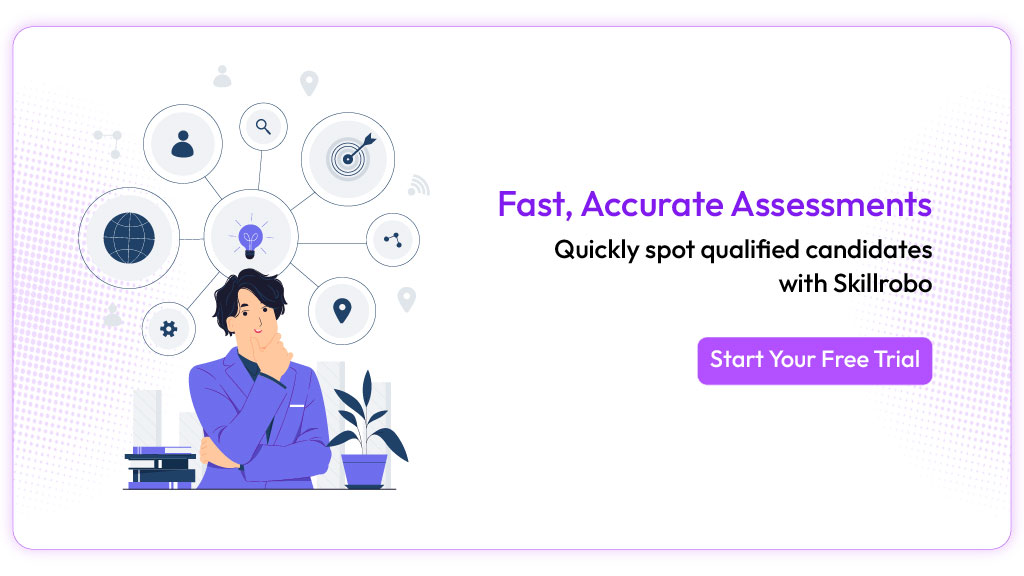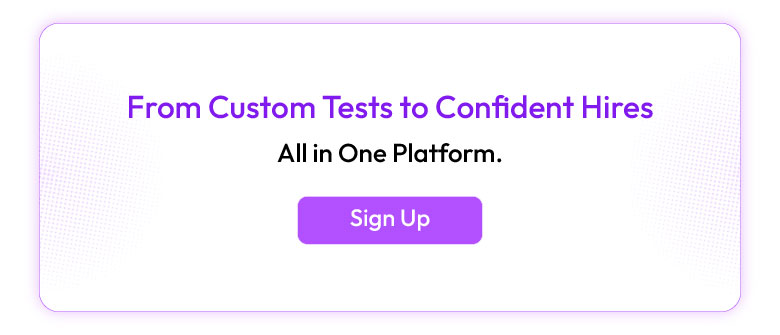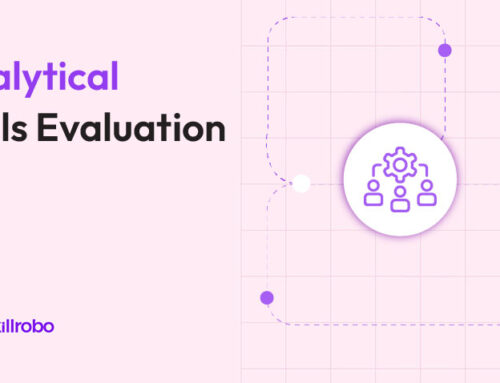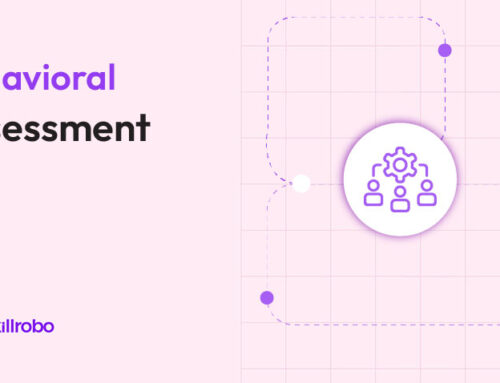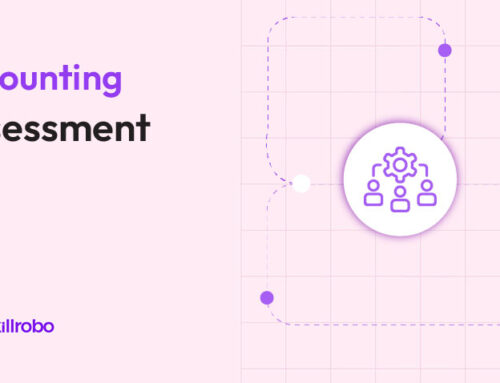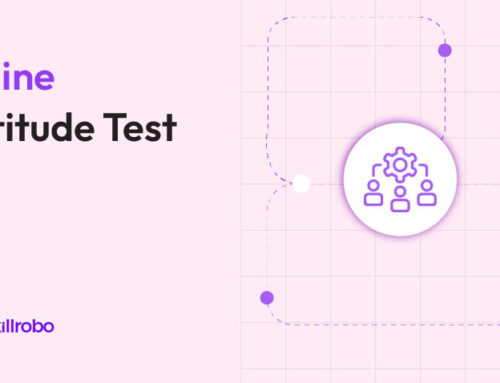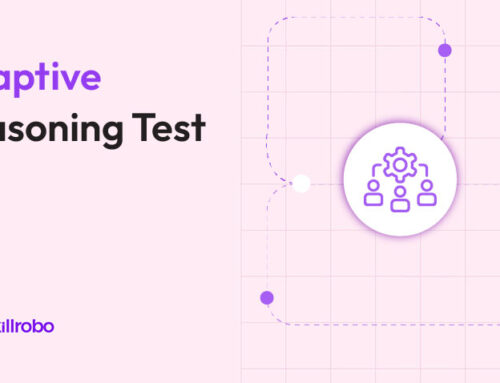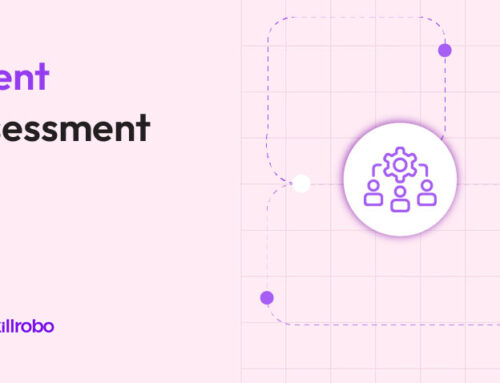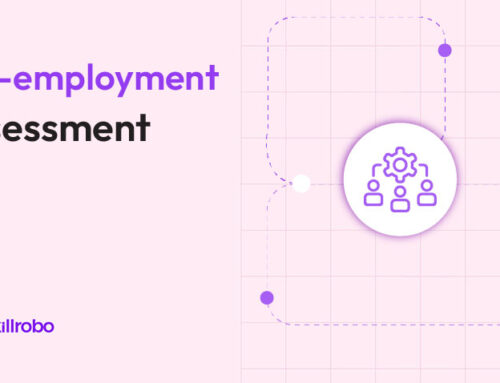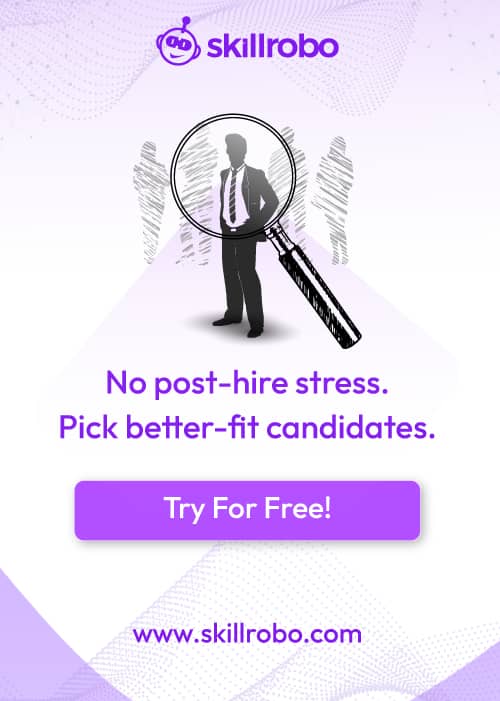Table of Contents
Related articles
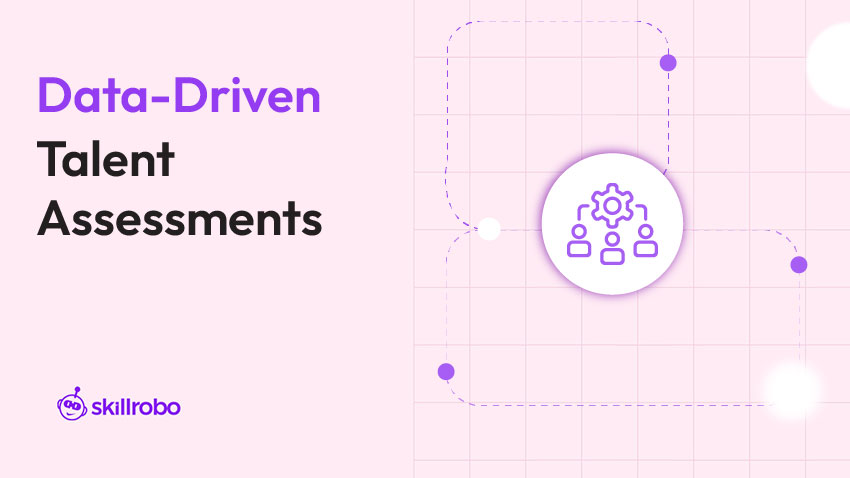
Key Takeaways
- Online talent assessment tools use measurable data to predict job success and improve hiring accuracy across industries.
- A data-driven hiring approach reduces bias by replacing gut decisions with objective skill assessments and analytics.
- Predictive analytics accelerates decision-making, lowers time-to-hire, and enhances overall recruitment efficiency.
- Skillrobo enables structured, role-specific hiring through customizable tests, AI-driven question generation, and instant reports.
The Shift Toward Objective Hiring
Traditional hiring methods—resumes, interviews, and gut instinct—often lead to inconsistent and biased decisions. While experience and intuition have their place, they don’t always provide a complete or reliable view of a candidate’s potential. Hence, data-driven hiring using online talent assessment tools has become the norm.
As businesses face growing pressure to hire faster and smarter, there’s a clear shift toward objective evaluation. This means relying on measurable data, like skill assessments and structured test results, rather than assumptions. Skill assessments and structured talent assessment processes are replacing assumptions
Online talent assessment tools now play a critical role in this transition, helping recruiters identify top talent based on performance, not perception. We’ll explore how to adopt data-driven hiring strategies and understand the key methods, benefits, and practical tools that enable objective, skill-based candidate evaluation in this blog.
Understanding Data-Driven Hiring
Data-driven hiring means using quantifiable insights, such as test scores, behavioral indicators, and skill evaluations, to select the best-fit candidates. It emphasizes measurable performance over assumptions, bringing consistency and fairness into recruitment.
This approach uses structured assessments, analytics, and benchmarking to evaluate how well a candidate matches the demands of a role. It moves beyond what a resume claims and focuses on how a candidate performs in relevant tasks.
According to HRWorld, companies applying predictive analytics to hiring processes are seeing stronger outcomes, including better job fit and higher retention.
How Online Talent Assessment Tools Enable Smarter Hiring
Online assessment platforms are at the core of a data-first hiring strategy. These tools help recruiters evaluate candidates across technical, cognitive, and soft skills using standardized, role-specific tests. By doing so, they eliminate guesswork and ensure that only qualified candidates move forward. Modern candidate assessment tools not only measure skillsets but also support automated shortlisting and benchmarking across departments.
Such platforms allow organizations to structure their hiring process around measurable data instead of relying on resumes or subjective impressions. Recruiters can compare applicants side by side based on performance, making selection more transparent and repeatable.
Insights from HiringBranch and PMAPS show that companies using structured assessments experience faster hiring cycles, reduced screening time, and stronger candidate-job alignment.
Moreover, these tools often integrate with applicant tracking systems and career portals, making them easy to scale across multiple roles and departments. Platforms that deliver standardized pre-employment tests help reduce screening time and increase the quality of hire.
Key Benefits of Data-Driven Hiring
Adopting a data-driven hiring approach does more than just streamline recruitment—it transforms it into a structured, evidence-based process. By prioritizing measurable performance and predictive insights, organizations can significantly reduce hiring risks and improve workforce quality.
Beyond improving accuracy, data-backed hiring brings scalability, transparency, and consistency across all stages of recruitment—from initial screening to final selection. The following benefits highlight why more companies are moving away from intuition-led hiring toward performance-driven evaluations.
1. Better Hiring Accuracy
When candidates are assessed through structured tests and analytics, hiring managers can make decisions based on proven capabilities. This leads to stronger hires who are better aligned with the job requirements.
It minimizes reliance on superficial indicators like resumes and helps identify top performers early in the funnel. Over time, this enhances team productivity and reduces the cost of bad hires. Structured pre-employment assessment tests ensure candidates are judged based on proven ability rather than unverified resumes.
2. Reduced Bias and Subjectivity
Objective assessments remove many of the unconscious biases that can affect decisions based on names, educational background, or appearance. Data ensures fairness in evaluating all candidates on equal grounds.
This leads to a more inclusive hiring process, promoting diversity and equity in recruitment. It also helps companies meet internal and external compliance expectations related to fair hiring practices.
3. Faster Decision-Making
With instant scoring and automated shortlisting, recruiters spend less time on manual resume reviews. This accelerates time-to-hire and allows HR teams to focus on high-impact tasks like interviews and onboarding.
Faster turnaround times also reduce the risk of losing top talent to competitors, giving companies a competitive edge in tight labor markets.
4. Improved Candidate Experience
Fair, role-relevant assessments demonstrate that a company values skill over background. Candidates appreciate the clarity and transparency that structured evaluations bring to the hiring process.
This creates a more engaging and respectful experience, improving employer branding and increasing the likelihood of candidates recommending the organization, even if they’re not hired.
5. Higher Offer Acceptance and Retention Rates
When candidates are placed in roles suited to their skills and potential, they’re more likely to accept offers and stay engaged long-term. Data alignment reduces mismatches and post-hire regret for both parties.
It also helps build more motivated teams and reduces early attrition, leading to better workforce stability and long-term performance. Better alignment through assessments strengthens both hiring and long-term talent management strategies.
Recruitment Metrics That Matter in Data-Driven Hiring
Data-driven hiring isn’t just about using assessments—it’s about continuously measuring and improving the effectiveness of your recruitment process. The right metrics give hiring teams a clear view of what’s working, where bottlenecks exist, and how closely hiring decisions align with organizational goals.
By tracking and analyzing key recruitment metrics, companies can make informed adjustments to their hiring strategy, ensuring better outcomes over time. Here are some of the most important data points to focus on:
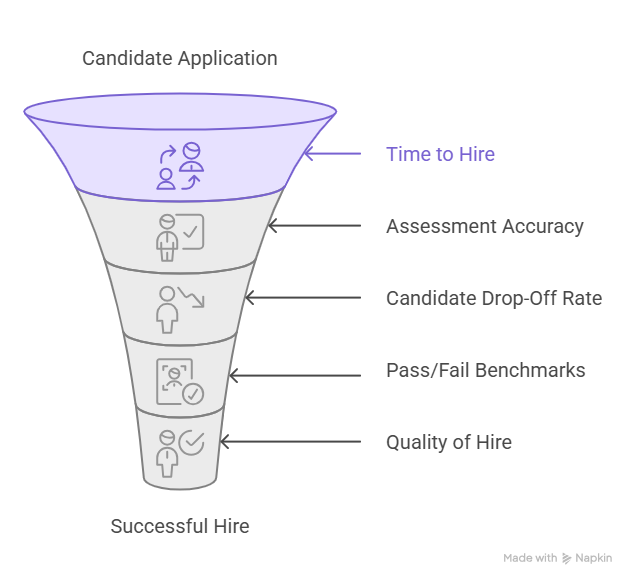
1. Time to Hire
This metric measures how long it takes to move a candidate from application to offer acceptance. A shorter time to hire often indicates an efficient and streamlined process, which is crucial in competitive job markets.
2. Assessment Accuracy
Evaluates how well assessment results predict job performance. The closer the correlation, the more effective your tests are in identifying high-potential candidates. Regular validation helps keep assessments aligned with real-world role expectations.
3. Candidate Drop-Off Rate
Tracks how many candidates abandon the process mid-way. High drop-off rates may signal that tests are too long, confusing, or poorly designed. Monitoring this helps improve the candidate experience and increase completion rates.
4. Pass/Fail Benchmarks
These benchmarks reflect how candidates are performing against pre-set scoring thresholds. They help recruiters identify top-tier applicants faster and ensure consistency in shortlisting across different hiring cycles. Many teams integrate employee evaluation software to align hiring decisions with long-term performance reviews and development goals.
5. Quality of Hire
One of the most valuable metrics it links hiring decisions to post-hire performance. Quality of hire is typically measured through feedback from managers, performance reviews, or retention within the first 6–12 months.
Challenges in Adopting Data-Driven Hiring
While the benefits of data-driven hiring are well-established, many organizations still face practical barriers that delay or limit adoption. Transitioning from traditional hiring practices to a data-centric model requires not only new tools but also a mindset shift across HR and leadership teams.
Some of the common challenges include:
1. Lack of Digital Infrastructure in HR Teams
Many organizations still rely on manual or semi-automated systems that aren’t built to support data-centric processes. Without a robust digital infrastructure, integrating online assessments and tracking analytics can be difficult and resource-intensive.
2. Concerns About Candidate Data Privacy
Collecting, storing, and analyzing candidate data raises valid privacy and compliance concerns. Companies must ensure that their hiring platforms comply with data protection regulations such as GDPR and maintain transparency with candidates about how their data is used.
3. Change Resistance from Hiring Managers
Hiring managers who are used to traditional methods, like unstructured interviews or resume filtering, may be skeptical of automated or data-based evaluations. Resistance can stem from a lack of understanding or fear of losing control over the decision-making process.
These challenges, however, are not insurmountable. They can be mitigated by selecting secure and intuitive hiring tools that offer role-based access, audit trails, and easy integration with existing HR systems. Training, internal communication, and gradual implementation also help build trust and promote adoption across teams.
How to Build an Ideal Data-Backed Hiring Workflow
An ideal data-driven hiring process should be simple, structured, and scalable. With the right tools in place, recruiters can reduce bias, increase accuracy, and improve overall efficiency without overcomplicating the workflow.
A simple five-step model includes:
- Designing skill-based assessments tailored to each role
Focus on role-specific competencies to ensure the test reflects actual job requirements. - Sharing tests via public URLs or ATS integration
Make it easy for candidates to access and complete assessments without added friction. - Monitoring test behavior using cheating prevention tools
Use features like webcam monitoring and tab-switch alerts to maintain test integrity. - Analyzing reports generated instantly after test completion
Review structured insights and scores to quickly identify high-potential candidates. - Progressing only the most qualified candidates to interviews
Focus interview efforts on candidates who meet the required benchmarks.
This streamlined approach ensures consistency, fairness, and speed throughout the recruitment cycle, enabling better decisions with less manual effort.
Skillrobo: Your Partner in Smart, Structured Hiring
Skillrobo is a powerful online assessment platform designed to enable objective, data-backed hiring decisions. Its robust features allow organizations to assess candidates efficiently and effectively, without relying on guesswork.
Why Recruiters Choose Skillrobo
- Customizable Tests: Build assessments tailored to job roles using multiple-choice, fill-in-the-blank, and descriptive formats.
- AI-Powered Test Generation: SEYARC AI creates relevant questions even for niche skills, accelerating test creation. Skillrobo’s AI talent assessment capabilities allow for rapid, accurate evaluation of even specialized skill sets.
- Cheating Prevention: Webcam monitoring, browser tab detection, and snapshot tracking ensure integrity.
- Public URL Access: Share tests easily via emails or career portals—no login required.
- Role-Based Access: Grant recruiters, managers, and stakeholders secure access to review candidate data.
- Instant Reporting: Auto-generated, categorized performance reports speed up the shortlisting process.
Skillrobo equips hiring teams with everything they need to make fast, fair, and data-informed recruitment decisions.
Conclusion
Data-driven hiring is no longer a trend, it’s a strategic necessity for organizations seeking to build stronger, more capable teams. By shifting from assumption-based decisions to structured evaluations, companies gain greater control over recruitment quality and efficiency.
Online talent assessment tools provide the foundation for this transformation, offering measurable insights that improve every stage of the hiring process from screening to final selection. When implemented correctly, data-backed hiring leads to better job fit, lower attrition, and more equitable candidate experiences.
Platforms like Skillrobo empower recruiters to take full advantage of this approach by offering customizable tests, instant reporting, AI-generated questions, and robust proctoring tools.
As hiring continues to evolve, organizations that embrace data-driven recruitment will be better positioned to attract, assess, and retain top talent with confidence and consistency. Ready to transform your hiring strategy? Sign up for Skillrobo today and start building smarter, data-driven recruitment workflows.

Key Takeaways
- Online talent assessment tools use measurable data to predict job success and improve hiring accuracy across industries.
- A data-driven hiring approach reduces bias by replacing gut decisions with objective skill assessments and analytics.
- Predictive analytics accelerates decision-making, lowers time-to-hire, and enhances overall recruitment efficiency.
- Skillrobo enables structured, role-specific hiring through customizable tests, AI-driven question generation, and instant reports.
The Shift Toward Objective Hiring
Traditional hiring methods—resumes, interviews, and gut instinct—often lead to inconsistent and biased decisions. While experience and intuition have their place, they don’t always provide a complete or reliable view of a candidate’s potential. Hence, data-driven hiring using online talent assessment tools has become the norm.
As businesses face growing pressure to hire faster and smarter, there’s a clear shift toward objective evaluation. This means relying on measurable data, like skill assessments and structured test results, rather than assumptions. Skill assessments and structured talent assessment processes are replacing assumptions
Online talent assessment tools now play a critical role in this transition, helping recruiters identify top talent based on performance, not perception. We’ll explore how to adopt data-driven hiring strategies and understand the key methods, benefits, and practical tools that enable objective, skill-based candidate evaluation in this blog.
Understanding Data-Driven Hiring
Data-driven hiring means using quantifiable insights, such as test scores, behavioral indicators, and skill evaluations, to select the best-fit candidates. It emphasizes measurable performance over assumptions, bringing consistency and fairness into recruitment.
This approach uses structured assessments, analytics, and benchmarking to evaluate how well a candidate matches the demands of a role. It moves beyond what a resume claims and focuses on how a candidate performs in relevant tasks.
According to HRWorld, companies applying predictive analytics to hiring processes are seeing stronger outcomes, including better job fit and higher retention.
How Online Talent Assessment Tools Enable Smarter Hiring
Online assessment platforms are at the core of a data-first hiring strategy. These tools help recruiters evaluate candidates across technical, cognitive, and soft skills using standardized, role-specific tests. By doing so, they eliminate guesswork and ensure that only qualified candidates move forward. Modern candidate assessment tools not only measure skillsets but also support automated shortlisting and benchmarking across departments.
Such platforms allow organizations to structure their hiring process around measurable data instead of relying on resumes or subjective impressions. Recruiters can compare applicants side by side based on performance, making selection more transparent and repeatable.
Insights from HiringBranch and PMAPS show that companies using structured assessments experience faster hiring cycles, reduced screening time, and stronger candidate-job alignment.
Moreover, these tools often integrate with applicant tracking systems and career portals, making them easy to scale across multiple roles and departments. Platforms that deliver standardized pre-employment tests help reduce screening time and increase the quality of hire.
Key Benefits of Data-Driven Hiring
Adopting a data-driven hiring approach does more than just streamline recruitment—it transforms it into a structured, evidence-based process. By prioritizing measurable performance and predictive insights, organizations can significantly reduce hiring risks and improve workforce quality.
Beyond improving accuracy, data-backed hiring brings scalability, transparency, and consistency across all stages of recruitment—from initial screening to final selection. The following benefits highlight why more companies are moving away from intuition-led hiring toward performance-driven evaluations.
1. Better Hiring Accuracy
When candidates are assessed through structured tests and analytics, hiring managers can make decisions based on proven capabilities. This leads to stronger hires who are better aligned with the job requirements.
It minimizes reliance on superficial indicators like resumes and helps identify top performers early in the funnel. Over time, this enhances team productivity and reduces the cost of bad hires. Structured pre-employment assessment tests ensure candidates are judged based on proven ability rather than unverified resumes.
2. Reduced Bias and Subjectivity
Objective assessments remove many of the unconscious biases that can affect decisions based on names, educational background, or appearance. Data ensures fairness in evaluating all candidates on equal grounds.
This leads to a more inclusive hiring process, promoting diversity and equity in recruitment. It also helps companies meet internal and external compliance expectations related to fair hiring practices.
3. Faster Decision-Making
With instant scoring and automated shortlisting, recruiters spend less time on manual resume reviews. This accelerates time-to-hire and allows HR teams to focus on high-impact tasks like interviews and onboarding.
Faster turnaround times also reduce the risk of losing top talent to competitors, giving companies a competitive edge in tight labor markets.
4. Improved Candidate Experience
Fair, role-relevant assessments demonstrate that a company values skill over background. Candidates appreciate the clarity and transparency that structured evaluations bring to the hiring process.
This creates a more engaging and respectful experience, improving employer branding and increasing the likelihood of candidates recommending the organization, even if they’re not hired.
5. Higher Offer Acceptance and Retention Rates
When candidates are placed in roles suited to their skills and potential, they’re more likely to accept offers and stay engaged long-term. Data alignment reduces mismatches and post-hire regret for both parties.
It also helps build more motivated teams and reduces early attrition, leading to better workforce stability and long-term performance. Better alignment through assessments strengthens both hiring and long-term talent management strategies.
Recruitment Metrics That Matter in Data-Driven Hiring
Data-driven hiring isn’t just about using assessments—it’s about continuously measuring and improving the effectiveness of your recruitment process. The right metrics give hiring teams a clear view of what’s working, where bottlenecks exist, and how closely hiring decisions align with organizational goals.
By tracking and analyzing key recruitment metrics, companies can make informed adjustments to their hiring strategy, ensuring better outcomes over time. Here are some of the most important data points to focus on:

1. Time to Hire
This metric measures how long it takes to move a candidate from application to offer acceptance. A shorter time to hire often indicates an efficient and streamlined process, which is crucial in competitive job markets.
2. Assessment Accuracy
Evaluates how well assessment results predict job performance. The closer the correlation, the more effective your tests are in identifying high-potential candidates. Regular validation helps keep assessments aligned with real-world role expectations.
3. Candidate Drop-Off Rate
Tracks how many candidates abandon the process mid-way. High drop-off rates may signal that tests are too long, confusing, or poorly designed. Monitoring this helps improve the candidate experience and increase completion rates.
4. Pass/Fail Benchmarks
These benchmarks reflect how candidates are performing against pre-set scoring thresholds. They help recruiters identify top-tier applicants faster and ensure consistency in shortlisting across different hiring cycles. Many teams integrate employee evaluation software to align hiring decisions with long-term performance reviews and development goals.
5. Quality of Hire
One of the most valuable metrics it links hiring decisions to post-hire performance. Quality of hire is typically measured through feedback from managers, performance reviews, or retention within the first 6–12 months.
Challenges in Adopting Data-Driven Hiring
While the benefits of data-driven hiring are well-established, many organizations still face practical barriers that delay or limit adoption. Transitioning from traditional hiring practices to a data-centric model requires not only new tools but also a mindset shift across HR and leadership teams.
Some of the common challenges include:
1. Lack of Digital Infrastructure in HR Teams
Many organizations still rely on manual or semi-automated systems that aren’t built to support data-centric processes. Without a robust digital infrastructure, integrating online assessments and tracking analytics can be difficult and resource-intensive.
2. Concerns About Candidate Data Privacy
Collecting, storing, and analyzing candidate data raises valid privacy and compliance concerns. Companies must ensure that their hiring platforms comply with data protection regulations such as GDPR and maintain transparency with candidates about how their data is used.
3. Change Resistance from Hiring Managers
Hiring managers who are used to traditional methods, like unstructured interviews or resume filtering, may be skeptical of automated or data-based evaluations. Resistance can stem from a lack of understanding or fear of losing control over the decision-making process.
These challenges, however, are not insurmountable. They can be mitigated by selecting secure and intuitive hiring tools that offer role-based access, audit trails, and easy integration with existing HR systems. Training, internal communication, and gradual implementation also help build trust and promote adoption across teams.
How to Build an Ideal Data-Backed Hiring Workflow
An ideal data-driven hiring process should be simple, structured, and scalable. With the right tools in place, recruiters can reduce bias, increase accuracy, and improve overall efficiency without overcomplicating the workflow.
A simple five-step model includes:
- Designing skill-based assessments tailored to each role
Focus on role-specific competencies to ensure the test reflects actual job requirements. - Sharing tests via public URLs or ATS integration
Make it easy for candidates to access and complete assessments without added friction. - Monitoring test behavior using cheating prevention tools
Use features like webcam monitoring and tab-switch alerts to maintain test integrity. - Analyzing reports generated instantly after test completion
Review structured insights and scores to quickly identify high-potential candidates. - Progressing only the most qualified candidates to interviews
Focus interview efforts on candidates who meet the required benchmarks.
This streamlined approach ensures consistency, fairness, and speed throughout the recruitment cycle, enabling better decisions with less manual effort.
Skillrobo: Your Partner in Smart, Structured Hiring
Skillrobo is a powerful online assessment platform designed to enable objective, data-backed hiring decisions. Its robust features allow organizations to assess candidates efficiently and effectively, without relying on guesswork.
Why Recruiters Choose Skillrobo
- Customizable Tests: Build assessments tailored to job roles using multiple-choice, fill-in-the-blank, and descriptive formats.
- AI-Powered Test Generation: SEYARC AI creates relevant questions even for niche skills, accelerating test creation. Skillrobo’s AI talent assessment capabilities allow for rapid, accurate evaluation of even specialized skill sets.
- Cheating Prevention: Webcam monitoring, browser tab detection, and snapshot tracking ensure integrity.
- Public URL Access: Share tests easily via emails or career portals—no login required.
- Role-Based Access: Grant recruiters, managers, and stakeholders secure access to review candidate data.
- Instant Reporting: Auto-generated, categorized performance reports speed up the shortlisting process.
Skillrobo equips hiring teams with everything they need to make fast, fair, and data-informed recruitment decisions.
Conclusion
Data-driven hiring is no longer a trend, it’s a strategic necessity for organizations seeking to build stronger, more capable teams. By shifting from assumption-based decisions to structured evaluations, companies gain greater control over recruitment quality and efficiency.
Online talent assessment tools provide the foundation for this transformation, offering measurable insights that improve every stage of the hiring process from screening to final selection. When implemented correctly, data-backed hiring leads to better job fit, lower attrition, and more equitable candidate experiences.
Platforms like Skillrobo empower recruiters to take full advantage of this approach by offering customizable tests, instant reporting, AI-generated questions, and robust proctoring tools.
As hiring continues to evolve, organizations that embrace data-driven recruitment will be better positioned to attract, assess, and retain top talent with confidence and consistency. Ready to transform your hiring strategy? Sign up for Skillrobo today and start building smarter, data-driven recruitment workflows.

